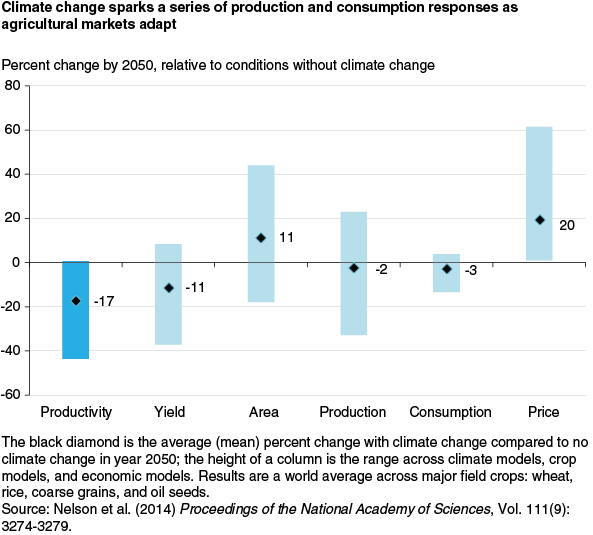Economic Responses Offset Potential Climate Change Impacts on Global Agriculture
- by Ron Sands
- 10/6/2014
On March 31, 2014, the Intergovernmental Panel on Climate Change (IPCC) released a comprehensive assessment of potential climate change impacts, including impacts on global crop production. The methodology used in the IPCC assessment begins with an ensemble of global climate models that simulate future temperature and precipitation in response to a range of possible greenhouse gas concentration scenarios. Output from the climate models is then used as input to crop growth models to simulate changes in crop productivity across crop types and location.
Staff at ERS and other research institutes in the U.S., Europe, and Japan have extended this modeling chain one step further by adding a group of nine global economic models that account for market adaptation to climate change. For the scenarios studied, higher global temperatures and reduced global average crop yields are expected. In response, farmers, consumers, and input suppliers are likely to alter their production and consumption patterns as prices adjust to changes in food supply and demand. Research indicates that a decrease in agricultural productivity due to climate change could be largely mitigated by increasing non-land inputs such as fertilizer and irrigation, increasing cropland area, and expanding international trade.
Given the wide range of crop growth models and economic modeling approaches used, there is considerable variability in projected agricultural outcomes. To better understand the degree of uncertainty implied by this variability in modeling results and to identify similarities across economic models, a common set of climate change and crop-yield model results were applied to the ERS Future Agricultural Resources Model and other global agricultural economic models.
Economic results are summarized by comparing the world in 2050 with and without climate change in a high greenhouse gas emissions scenario. The average projected climate-change-induced decline in productivity across four major field crops is 17 percent. However, the average projected decline in global consumption of these crops is only 3 percent, with economic adaptation making up the difference.
The climate-change-induced drop in productivity leads to changes in crop yield, cropland area, and location of production, with only a small decline in world average production and consumption of major field crops. International trade reduces the large geographic variation in productivity levels to a much narrower range of changes in world crop consumption. However, maintaining crop consumption near levels that would be expected without climate change comes at a cost. All nine economic models project an increase in the inflation-adjusted price of crops, with the average price increasing 20 percent.
This article is drawn from:
- “Climate change effects on agriculture: Economic responses to biophysical shocks”. (2014). in Proceedings of the National Academy of Sciences, Vol. 111, no. 9: 3274-3279. by Gerald C. Nelson, Hugo Valin, Ronald D. Sands, Petr Havlik, Helal Ahammad, Delphine Deryng, Joshua Elliott, Shinichiro Fujimori, Tomoko Hasegawa, Edwina Heyhoe, Page Kyle, Martin Von Lampe, Hermann Lotze-Campen, Daniel Mason d’Croz, Hans van Meijl, Dominique van der Mensbrugghe, Christoph Müller, Alexander Popp, Richard Robertson, Sherman Robinson, Erwin Schmid, Christoph Schmitz, Andrzej Tabeau, and Dirk Willenbockel..
We’d welcome your feedback!
Would you be willing to answer a few quick questions about your experience?


